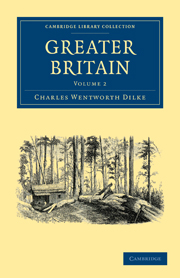Book contents
- Frontmatter
- Contents
- LIST OF ILLUSTRATIONS
- PART III
- CHAP. I SYDNEY
- CHAP. II RIVAL COLONIES
- CHAP. III VICTORIA
- CHAP. IV SQUATTER ARISTOCRACY
- CHAP. V COLONIAL DEMOCRACY
- CHAP. VI PROTECTION
- CHAP. VII LABOUR
- CHAP. VIII WOMAN
- CHAP. IX VICTORIAN PORTS
- CHAP. X TASMANIA
- CHAP. XI CONFEDERATION
- CHAP. XII ADELAIDE
- CHAP. XIII TRANSPORTATION
- CHAP. XIV AUSTRALIA
- CHAP. XV COLONIES
- PART IV
- INDEX
- Plate section
CHAP. IX - VICTORIAN PORTS
Published online by Cambridge University Press: 29 August 2010
- Frontmatter
- Contents
- LIST OF ILLUSTRATIONS
- PART III
- CHAP. I SYDNEY
- CHAP. II RIVAL COLONIES
- CHAP. III VICTORIA
- CHAP. IV SQUATTER ARISTOCRACY
- CHAP. V COLONIAL DEMOCRACY
- CHAP. VI PROTECTION
- CHAP. VII LABOUR
- CHAP. VIII WOMAN
- CHAP. IX VICTORIAN PORTS
- CHAP. X TASMANIA
- CHAP. XI CONFEDERATION
- CHAP. XII ADELAIDE
- CHAP. XIII TRANSPORTATION
- CHAP. XIV AUSTRALIA
- CHAP. XV COLONIES
- PART IV
- INDEX
- Plate section
Summary
All allowance being made for the great number of wide roads for trade, there is still a singular absence of traffic in the Melbourne streets. Trade may be said to be transacted only upon paper in the city, while the tallow, grain, and wool, which form the basis of Australian commerce, do not pass through Melbourne, but skirt it, and go by railway to Williamstown, Sandridge, and Geelong.
Geelong, once expected to rival Melbourne, and become the first port of all Australia, I found grass-grown and half deserted, with but one vessel lying at her wharf. At Williamstown, a great fleet of firstclass ships was moored alongside the pier. When the gold-find at Ballarat took place, Geelong rose fast as the digging port, but her citizens chose to complete the railway line to Melbourne instead of first opening that to Ballarat, and so lost all the up-country trade. Melbourne, having once obtained the lead, soon managed to control the Legislature, and grants were made for the Echuca Railroad, which tapped the Murray, and brought the trade of Upper Queensland and New South Wales down to Melbourne, in the interest of the ports of Williamstown and Sandridge. Not content with ruining Geelong, the Melbourne men have set themselves to ridicule it. One of their stories goes that the Geelong streets bear such a fine crop of grass, that a free selector has applied to have them surveyed and sold to him, under the 42nd clause of the New Land Act.
- Type
- Chapter
- Information
- Greater Britain , pp. 88 - 92Publisher: Cambridge University PressPrint publication year: 2009First published in: 1868



